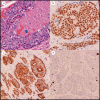Metastatic neuroendocrine carcinoma presenting with left lateral rectus enlargement and orbital cellulitis
- PMID: 34456492
- PMCID: PMC8366931
- DOI: 10.1080/08998280.2021.1930633
Metastatic neuroendocrine carcinoma presenting with left lateral rectus enlargement and orbital cellulitis
Abstract
Neuroendocrine tumors (NETs) of the orbit are a rare but increasingly recognized clinical phenomenon. The vast majority of orbital NETs are metastatic, and most metastasize from the gastrointestinal system to the extraocular muscles. While orbital metastasis typically occurs in the setting of a known primary neoplasm, some cases represent the initial manifestation of disease and can precede detection of the primary tumor by many months. We report a 58-year-old woman who presented with diplopia, unilateral orbital pain, erythema, and chemosis as the primary presentation of a metastatic small intestine NET. This case serves as a reminder that identification of orbital NETs should prompt investigation for primary gastrointestinal or pulmonary NETs. Goals of surgery include obtaining a tissue sample, debulking the lesion, and preserving visual function.
Keywords: Midgut; neuroendocrine tumor; orbital metastasisneuroendocrine tumor.
Copyright © 2021 Baylor University Medical Center.
Figures


Similar articles
-
The eye of the beholder: orbital metastases from midgut neuroendocrine tumors, a two institution experience.Cancer Imaging. 2018 Dec 6;18(1):47. doi: 10.1186/s40644-018-0181-5. Cancer Imaging. 2018. PMID: 30522522 Free PMC article.
-
Neuroendocrine tumour metastasis to the orbit.Endokrynol Pol. 2019;70(5):455-456. doi: 10.5603/EP.a2019.0024. Epub 2019 May 28. Endokrynol Pol. 2019. PMID: 31135056
-
Uncommon orbital metastasis in ductal breast carcinoma: a rare presentation 12 years after treatment.J Surg Case Rep. 2024 Jun 27;2024(6):rjae428. doi: 10.1093/jscr/rjae428. eCollection 2024 Jun. J Surg Case Rep. 2024. PMID: 38938683 Free PMC article.
-
Orbital metastasis as the primary manifestation of pancreatic carcinoma: a case report and literature review.BMC Ophthalmol. 2022 Mar 12;22(1):116. doi: 10.1186/s12886-022-02337-7. BMC Ophthalmol. 2022. PMID: 35279125 Free PMC article. Review.
-
Diagnostic and Therapeutic Management of Primary Orbital Neuroendocrine Tumors (NETs): Systematic Literature Review and Clinical Case Presentation.Biomedicines. 2024 Feb 6;12(2):379. doi: 10.3390/biomedicines12020379. Biomedicines. 2024. PMID: 38397981 Free PMC article. Review.
References
Publication types
LinkOut - more resources
Full Text Sources
